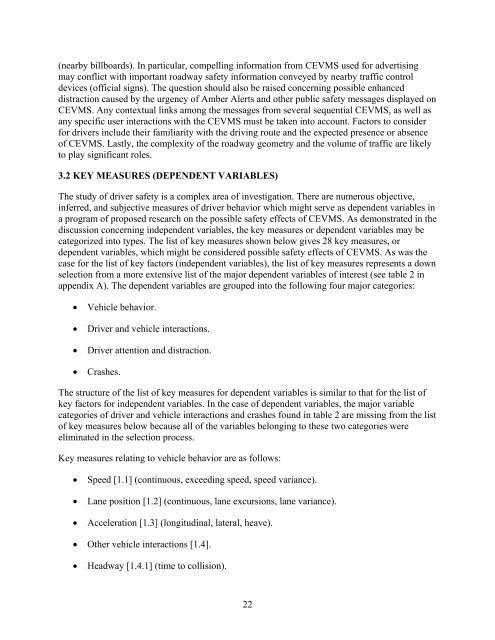The Effects of Commercial Electronic Variable Message Signs ...
The Effects of Commercial Electronic Variable Message Signs ...
The Effects of Commercial Electronic Variable Message Signs ...
Create successful ePaper yourself
Turn your PDF publications into a flip-book with our unique Google optimized e-Paper software.
(nearby billboards). In particular, compelling information from CEVMS used for advertising<br />
may conflict with important roadway safety information conveyed by nearby traffic control<br />
devices (<strong>of</strong>ficial signs). <strong>The</strong> question should also be raised concerning possible enhanced<br />
distraction caused by the urgency <strong>of</strong> Amber Alerts and other public safety messages displayed on<br />
CEVMS. Any contextual links among the messages from several sequential CEVMS, as well as<br />
any specific user interactions with the CEVMS must be taken into account. Factors to consider<br />
for drivers include their familiarity with the driving route and the expected presence or absence<br />
<strong>of</strong> CEVMS. Lastly, the complexity <strong>of</strong> the roadway geometry and the volume <strong>of</strong> traffic are likely<br />
to play significant roles.<br />
3.2 KEY MEASURES (DEPENDENT VARIABLES)<br />
<strong>The</strong> study <strong>of</strong> driver safety is a complex area <strong>of</strong> investigation. <strong>The</strong>re are numerous objective,<br />
inferred, and subjective measures <strong>of</strong> driver behavior which might serve as dependent variables in<br />
a program <strong>of</strong> proposed research on the possible safety effects <strong>of</strong> CEVMS. As demonstrated in the<br />
discussion concerning independent variables, the key measures or dependent variables may be<br />
categorized into types. <strong>The</strong> list <strong>of</strong> key measures shown below gives 28 key measures, or<br />
dependent variables, which might be considered possible safety effects <strong>of</strong> CEVMS. As was the<br />
case for the list <strong>of</strong> key factors (independent variables), the list <strong>of</strong> key measures represents a down<br />
selection from a more extensive list <strong>of</strong> the major dependent variables <strong>of</strong> interest (see table 2 in<br />
appendix A). <strong>The</strong> dependent variables are grouped into the following four major categories:<br />
• Vehicle behavior.<br />
• Driver and vehicle interactions.<br />
• Driver attention and distraction.<br />
• Crashes.<br />
<strong>The</strong> structure <strong>of</strong> the list <strong>of</strong> key measures for dependent variables is similar to that for the list <strong>of</strong><br />
key factors for independent variables. In the case <strong>of</strong> dependent variables, the major variable<br />
categories <strong>of</strong> driver and vehicle interactions and crashes found in table 2 are missing from the list<br />
<strong>of</strong> key measures below because all <strong>of</strong> the variables belonging to these two categories were<br />
eliminated in the selection process.<br />
Key measures relating to vehicle behavior are as follows:<br />
• Speed [1.1] (continuous, exceeding speed, speed variance).<br />
• Lane position [1.2] (continuous, lane excursions, lane variance).<br />
• Acceleration [1.3] (longitudinal, lateral, heave).<br />
• Other vehicle interactions [1.4].<br />
• Headway [1.4.1] (time to collision).<br />
22

















